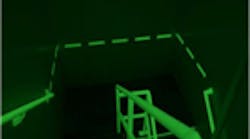Phosphors, the key ingredient in photoluminescent products, contain rare earth elements that are found in mixed geological deposits throughout the world. When added to ink, dye, paint, coatings and moldings, those products can be charged by exposure to light so they can absorb, store and then emit light at a later time.
Long-persistence phosphors, like a sponge, are able to absorb and hold the light energy, slowly releasing it to provide illumination over an extended period of time. But long-persistence phosphor’s storage capability does not come naturally. That’s where phosphor science comes in.
“Photoluminescent technology is really a marriage of physics and chemistry,” said Allen Sexton, general manager of US Phosphor. “Phosphors can be modified in a lab setting to take on different characteristics. Depending on whether an end user needs a product that is especially bright, lasts a long time or displays a different color is a matter of re-engineering the phosphor properties in the lab.”
In 2009, the International Building Code and International Fire Code was revised to mandate the use of photoluminescent technology in new and existing high-rise buildings. The maritime industry, via the International Convention for Safety of Life at Sea, also recently mandated the use of photoluminescent materials for safety and rescue products.
“Photoluminescent materials for safety and egress have been on the rise since 9/11,” said Rob Jessup, president of Jessup Manufacturing. “In fact, these phosphor-based products performed so well at the twin towers marking stairwells and exits that in 2005, New York passed New York Local Law 26 (LL26), a revision to the standard building code that mandates the use of phosphor-based photoluminescent technology for the purpose of safety and egress in all buildings over 75 feet high.”
Lighting the Way to Safety
When the Chicago Transit Authority (CTA) faced a potentially dangerous no-light/low-light situation in tunnels and along emergency exits in 2006, it underwent an extensive subway safety upgrade that included phosphor-based photoluminescent paint. As a result, the photoluminescent paint on the handrails, walls and stairs in about 50 subway emergency exits shined brightly to help direct passengers to exits and escape routes in emergency situations.
In addition to the safety applications, phosphor-based products are environmentally friendly. Phosphor does not contain radioactive materials or toxic metals, so it presents very low health risk for the environment and for the personnel who handle it. And when supplemental power sources cannot be provided, products containing long-persistence phosphor can be seen for long periods of time, even in conditions of low or no ambient light.
Photoluminescent products also may be an economical choice. Say you’re the facilities manager at a stadium that features steep, upper-deck stairways that lack adequate light. Improving the lighting and adding to the infrastructure could cost $1-3 million plus annual maintenance. Another option is to supplement existing lighting with photoluminescent products, which would cost as little as $200,000 for photoluminescent paint and labor, with no routine maintenance required for the first 2-3 years.
So how is this alternative safety lighting best deployed? Coated adhesive-backed films, markings and signage dominate the safety and egress business, partly because they are mandated by building and marine codes, but also because they feature lower installation cost and ease of application compared to paint products.
Whether you call it a safety net or call it a back-up plan, long-persistence phosphor-based products may be a wise choice – sometimes a mandated choice – for facilities managers with egress responsibilities.
Chuck Shuty, director of sales at US Phosphor, has over 25 years of experience in the specialty chemical industry. He has worked for Sun Chemical, Akzo Nobel, Valspar and Nalco Chemical in sales, marketing and new product introduction. He can be reached at [email protected].


